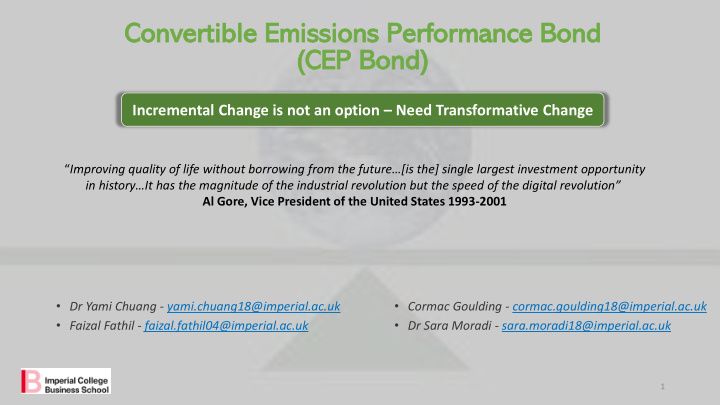



Convertib ible le Emis issio ions Performance Bond (C (CEP Bond) Incremental Change is not an option – Need Transformative Change “ Improving quality of life without borrowing from the future…[is the] single largest investment opportunity in history…It has the magnitude of the industrial revolution but the speed of the digital revolution” Al Gore, Vice President of the United States 1993-2001 • Dr Yami Chuang - yami.chuang18@imperial.ac.uk • Cormac Goulding - cormac.goulding18@imperial.ac.uk • Faizal Fathil - faizal.fathil04@imperial.ac.uk • Dr Sara Moradi - sara.moradi18@imperial.ac.uk 1
CEP Bond – Addresses weaknesses and complements existing solutions Current Economic Environment Carbon TAX ➢ No upper bound on emissions ➢ Pressure on all sectors to reduce emissions – ➢ Problem Shifting target of 7.6% p.a. (UN) ➢ Increases Costs - Politically unpopular ➢ Massive investment shortfall – IPCC ➢ Companies requiring structural investments need access to cheap finance Cap-and-Trade ➢ Undermined by exemptions & subsidies ➢ Issuers and institutional investors keen to ➢ Queries over use of proceeds implement ESG strategies ➢ Problem Shifting ➢ 8% fall in emissions expected in 2020 at an economic cost of €1,750 per tonne of Carbon* Climate Bonds ➢ High cost means we need to invest to replace ➢ Uncertainty of qualifying criteria fossil fuels, can't shrink the economy ➢ Difficult to measure impact * Breakthrough Institute https://thebreakthrough.org/issues/energy/covid-co2-drop
CEP Bond – Incentivises transformative change in tackling climate issues • • Benefits all stakeholders Contributes to solutions Impact Investing • Complements existing mechanisms Clear Standards • • Use of proceeds reporting Emissions impact reporting (GHGs) • • Reduces capital costs Future proofing Value Creation • • Diversifies options Higher returns for Investors • Feasible: Adapts existing mechanism Scalable Solution • Scalable: Applicable to all publicly listed companies • Incentivises transition to a low-carbon economy Reduces GHGs • Reduces GHG Emissions
CEP Bond – Structure provides sound, objective green-financing option Issuer GHG-reducing Projects Investors Purchase fixed-term bond Provide green project financing Periodical interest payments Lower GHG emissions At maturity: GHG-target UNMET No conversion, pay principle & interest At maturity: GHG-target MET convertible to common stocks Complies with Cheaper financing vs Returns vs Climate financing conventional bonds 2 conventional bond 3 gaps to fill 1 guidelines 1 According to IPCC estimates of $1.6-3.8 trillion annual climate financing needed and current green bond issuance volume of around $600 billion 2 Average spreads between conventional bonds (Bloomberg USD Investment Grade Bond Index) and convertible bonds (Bloomberg USD Convertible Bond Index) in 2015-20 3 Annualised returns between convertible (Bloomberg USD Convertible Bond Index) and conventional bonds (Bloomberg USD Investment Grade Bond Index) in 2015-20
CEP Bond – A feasible framework for future climate-based financing Innovative Feasible Adapts Convertible Bond to Aligns issuers, investors & new solution climate objectives CEP Bond Impactful Scalable Linked to specific, pre- Complementary, fits diverse determined emissions targets climate financing needs 5
Recommend
More recommend